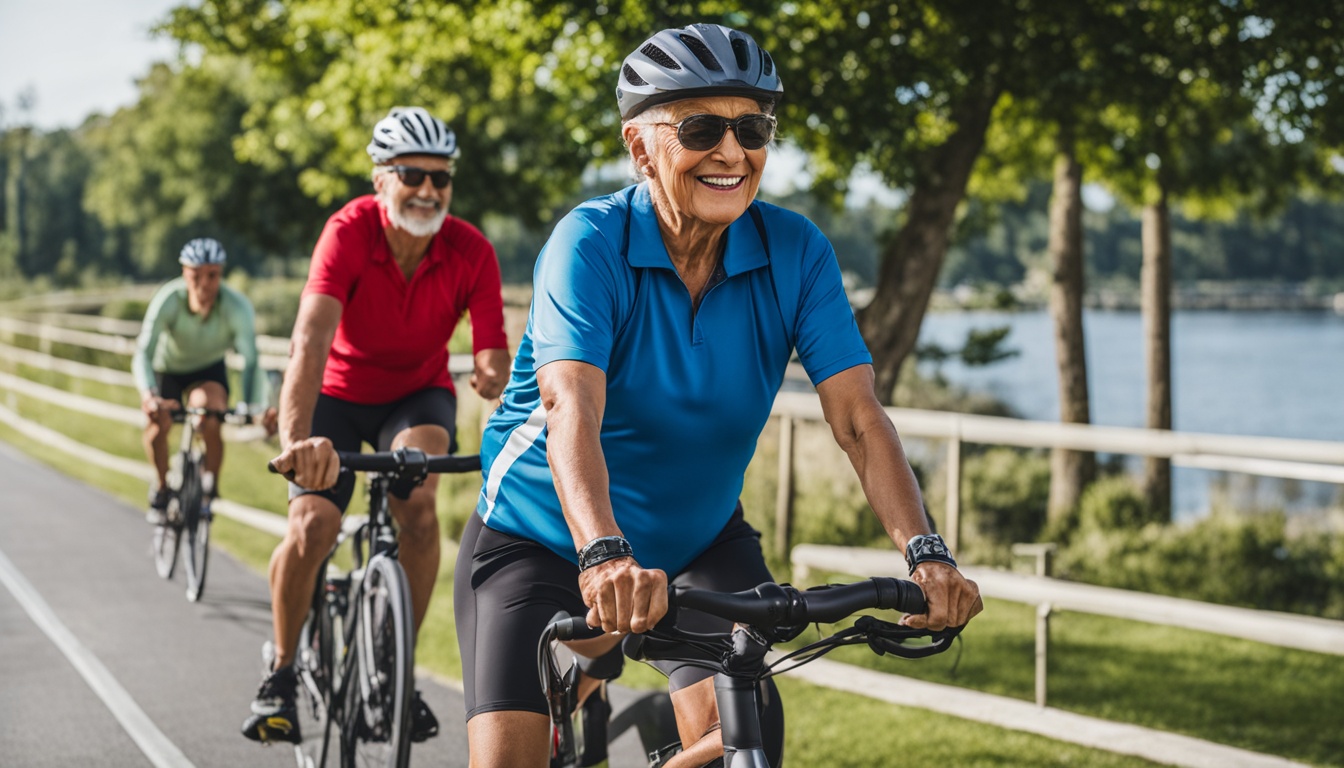For seniors, staying active is key to maintaining their health and wellness. This guide offers tips and routines for a more active life. Regular exercise is vital—it boosts both physical and mental health, supports independence, and enhances life quality. A Swedish study showed that physical activity is the top factor in longevity, proving that starting exercise later in life can add years to your life.
Physical activities help fight the dangers of a sedentary lifestyle. Seniors who exercise regularly tend to have better immune function, lower blood pressure, and a reduced risk of diseases like Alzheimer’s and heart disease. Exercise also improves mobility, flexibility, and balance, lowering the chance of falls. With so many health benefits, staying active is crucial for aging individuals on their fitness journey.
Key Takeaways
- Regular exercise improves overall physical and mental health.
- Statistics reveal that staying active can enhance longevity.
- Engaging in fitness activities prevents numerous health issues.
- Physical activity enhances balance, reducing fall risks.
- It’s never too late to start exercising for better health.
Why Staying Active is Crucial for Seniors
Engaging in aging adults fitness is vital for maintaining overall health and well-being. The health risks of inactivity can be severe, leading to chronic diseases like heart disease and diabetes. Even small amounts of physical activity, such as just five minutes a day, can provide essential health benefits. Regular exercise not only mitigates these risks but also enhances mood and cognitive function.
It is recommended that seniors aim for at least 150 minutes of moderate-intensity aerobic activity each week. Incorporating muscle-strengthening exercises at least two days a week can further bolster health. Practical activities like practicing standing on one foot can improve balance, reducing the likelihood of falls, an important consideration for older adults.
When seniors combine different types of exercise, such as aerobic workouts and strength training, they experience even greater advantages. Consulting with a physical activity specialist can ensure personalized routines that fit specific needs. Assessing the impact of medications on physical activity response adds another layer of safety.
Staying active has profound effects on cognitive health, with studies indicating a lower risk of dementia among physically active seniors. Exercise also fosters social interactions, alleviating feelings of loneliness and depression by maintaining social ties and promoting a sense of purpose. In senior living communities, residents often engage more in physical activities compared to those living alone, highlighting the importance of an active lifestyle.

The connection between physical fitness and cardiovascular health is undeniable. Daily cardiovascular activities are key to a healthy heart, and classes such as aqua workouts offer an excellent environment for protecting joint health while enhancing fitness. As metabolism tends to slow with age, maintaining a regular exercise routine helps manage weight and prevent various health issues.
Engaging in resistance exercises is crucial for safeguarding muscle strength and bone density, protecting against potential fractures. The relationship between improved balance and coordination through targeted exercises is particularly important for older adults, helping to prevent serious fall-related injuries. Incorporating a diverse range of activities strengthens not only the body but also supports the mental health of seniors.
Benefits of Regular Exercise for Seniors
Regular exercise is a cornerstone for seniors, significantly boosting health and life quality. It aids in weight management by increasing metabolism and calorie burn. This is crucial for seniors, who often struggle to maintain a healthy weight.
Engaging in physical activities enhances mobility and flexibility, key for preventing falls. It also strengthens balance and resilience, essential for overcoming age-related physical challenges. Thus, regular exercise is a powerful tool against the physical frailties of aging.

Exercise significantly benefits mental health, too. It releases endorphins, which elevate mood and reduce anxiety. Over time, this leads to better self-esteem and improved cognitive functions like memory and decision-making.
For seniors aged 65 and older, guidelines suggest at least 2.5 hours of moderate aerobic exercise weekly, along with strength training two times a week. This regimen not only boosts physical abilities but also ensures a safer, healthier lifestyle.
To fully reap the benefits of regular exercise, seniors should focus on activities that enhance balance and flexibility. Incorporating physical activity into daily routines, such as walking the dog or doing light exercises while watching TV, makes exercise a seamless part of life.
Fitness for Seniors: Key Types of Exercises
For seniors, staying active is crucial, and engaging in various fitness activities can boost health and well-being. This variety keeps workouts interesting and targets different fitness areas. Begin with aerobic exercises like walking, swimming, or dancing. Aim for 150 minutes of moderate-intensity activity weekly, split into 30-minute sessions five times a week.
Strength training is vital for maintaining muscle mass as aging progresses. Engage in muscle-strengthening activities two to three times a week using free weights or resistance bands. These routines not only enhance muscle to fat ratio but also boost bone strength. It’s advised that seniors include exercises like bicep curls or chair squats in their routine for effective outcomes.
Balance exercises are essential for preventing falls. Activities such as tai chi or yoga can greatly improve stability and confidence. Adding these short sessions to your weekly routine ensures better mobility and independence. Flexibility exercises are also crucial for maintaining muscle flexibility; gentle stretching suits all ability levels, including seated options.
Combining different senior workout routines benefits both physical and mental health. Aerobic activities reduce stress, uplift mood, and enhance life quality. Prioritizing a mix of these exercises promotes a healthier, more active lifestyle.
The Importance of Strength Training for Seniors
As aging progresses, the importance of senior strength training becomes clear. About 30% of adults over 70 face mobility issues, making simple tasks like walking or climbing stairs challenging. Muscle mass and strength decline naturally, peaking in the mid-30s and accelerating post-65 for women and post-70 for men. This decline highlights the critical benefits of strength exercises for elderly individuals.
Resistance training is crucial for preventing frailty and improving mobility in older adults. Weightlifting, especially for those with obesity, offers significant benefits when combined with dietary changes. These exercises stimulate muscle growth and enhance bone health, preventing osteoporosis and frailty.
Regular strength-training helps maintain strength, dignity, and independence in older individuals. Experts recommend incorporating strength training twice a week, alongside aerobic activities for a comprehensive fitness plan. Simple exercises like chair squats and wall push-ups are great for beginners, requiring minimal time and equipment.
Strength training yields numerous health benefits, including better balance and coordination, which reduces fall risks. A consistent program supports a vibrant, independent life into old age. Adopting strength training as a lifelong habit boosts physical well-being and enhances daily activity confidence.
Activities That Boost Cardiovascular Health
Engaging in cardiovascular exercise for seniors is crucial for heart health and overall well-being. It enhances circulation, lowers blood pressure, and improves heart rate. This leads to better cardiovascular function. Aim for at least 150 minutes of moderate-intensity aerobic exercise weekly, ideally in 30-minute sessions, five days a week.
Brisk walking, swimming, cycling, and dancing are excellent choices for seniors wanting to boost their cardiovascular health. These activities enhance heart function, increase lung capacity, and build endurance for everyday tasks. Playing tennis or joining group classes can make exercise a social activity, making it more enjoyable and motivating.
Adding resistance training to your routine is also beneficial. Aim to do resistance activities at least two nonconsecutive days each week. This supports lean muscle mass, reduces body fat, and may improve cholesterol levels, further enhancing heart health.
Balance and flexibility exercises, like yoga and tai chi, complement cardiovascular exercise. They help maintain joint flexibility and musculoskeletal health, preventing injuries and ensuring safe participation in aerobic and resistance activities. Incorporate stretching into your daily routine, especially before and after workouts, to enhance stability and reduce fall risks.
These heart-healthy activities offer numerous benefits. They improve heart health, reduce the risk of chronic diseases, enhance cognitive function, and improve sleep quality. Regular exercise also helps alleviate symptoms of depression and anxiety, leading to a better quality of life.
Enhancing Balance and Flexibility with Low-Impact Workouts
Low-impact exercises are vital for seniors to improve balance and flexibility. Activities like yoga and Tai Chi enhance posture, increase motion range, and support joint health. These workouts are tailored to lower the risk of falls, a major concern for the elderly. They make you feel more stable and confident in daily activities.
Stretching routines are key to boosting flexibility. These exercises are crucial for maintaining functional movements and agility. They help you perform daily tasks with ease. Regularly engaging in these exercises creates a safe and supportive environment, allowing you to stay active and thrive.
When starting balance and flexibility training, mix different low-impact workouts into your routine. This approach not only boosts your physical health but also supports mental well-being. The benefits of these exercises go beyond physical fitness, encouraging social connections and a sense of community in group settings.

Tips for Creating a Senior Workout Routine
Creating effective senior workout routines demands a thoughtful approach. It’s essential to consider your current fitness level and goals. By incorporating simple exercise tips for seniors, you can establish a routine that boosts both your physical and mental health. Begin with a focus on balance, strength, and endurance to build a strong foundation for your well-being.
Start Slow and Gradually Increase Intensity
When starting a new exercise routine, begin with short sessions, possibly as little as five minutes of light activity. This approach allows your body to adjust and minimizes the risk of injury. Regularly evaluate your progress and increase your workout duration as you feel ready. It’s crucial to listen to your body; pushing too hard can lead to setbacks that hinder your fitness journey.
Mix Different Types of Activities
Variety is key to keeping workouts engaging and effective. Switching between different exercises—like cardio, strength training, and flexibility workouts—improves overall fitness. Activities such as walking, swimming, and yoga keep you motivated while enhancing heart health, building muscle, and improving flexibility. For more insights on balanced workouts, check out this balanced workout resource. A holistic approach leads to better results and reduces the risk of falls, ensuring you remain active and healthy.
Exercises for Elderly: Simple and Effective Options
For seniors, staying active is crucial. There are many exercises tailored to their needs. Adding simple fitness options for seniors can boost mobility, strength, and overall health. Here are some effective exercises to consider:
Calisthenics for Seniors
Calisthenics are perfect for older adults wanting to improve their fitness without heavy equipment. You can do push-ups and squats at your own pace. These exercises not only build strength but also improve coordination and balance, crucial for everyday tasks. With simple adjustments, they become accessible and beneficial for nearly everyone.
Chair Exercises
Chair exercises are great for those with mobility issues. You can do seated leg lifts and arm circles while sitting. These exercises for elderly people help with circulation and muscle strength, keeping you safe and stable.
Walking and Strolling
Walking supports heart health and offers chances for socializing and enjoying nature. Try different walking styles like strolling, various strides, and even backward walking to improve balance and endurance. Aim for 150 minutes of such activities weekly to reduce fall risks and enhance happiness. For more tips on staying active, see this guide on women’s fitness.
Senior Health and Wellness: Nutrition & Hydration
Nutrition is crucial for senior health and wellness. A diet rich in fruits, vegetables, whole grains, lean proteins, and healthy fats boosts energy for exercise. Proper nutrition tips for seniors are vital for their well-being. Lean meats, fish, and poultry offer essential protein for muscle upkeep and recovery.
Hydration is key for seniors’ daily health. They should drink at least 8 cups of fluids daily for optimal body function. Staying hydrated helps with digestion, regulates body temperature, and supports circulation. _Remember_, it’s crucial during exercise to prevent dehydration and maintain vitality.

Seniors must monitor their nutrient intake. Calcium and Vitamin D are crucial for bone health, while vitamins B6, B12, and folate support healthy aging. It’s important to limit sodium intake to less than 2,300 mg daily to avoid high blood pressure.
Regular medical check-ups are essential for seniors to monitor their health. Screenings for blood pressure, cholesterol, and blood sugar levels are vital for good health. With attention to diet, hydration, and medical care, seniors can improve their quality of life and maintain independence and vitality.
Overcoming Common Myths about Senior Exercise
The landscape of senior fitness is often shrouded by numerous myths. Many believe aging limits physical activity, fearing exercise will lead to injury. However, regular exercise is crucial for a longer, healthier life. It boosts overall health and lowers the risk of chronic conditions like obesity, diabetes, and heart disease.
It’s vital to challenge these misconceptions to encourage a more active lifestyle. Strength training, for example, helps manage arthritis symptoms and benefits those with disabilities. Custom exercise programs can improve your range of motion, muscle tone, and heart health. This shows it’s never too late to begin.
Some seniors believe exercise worsens conditions like arthritis. Yet, the Arthritis Foundation advocates for physical activity to reduce arthritis pain. No chronic condition is immune to exercise’s benefits, emphasizing the importance of consulting with healthcare professionals before starting a routine.
Physical activity not only reduces depression and anxiety but also enhances mental clarity and independence. Research shows older adults can safely start exercising in their 70s and 80s. This highlights the potential benefits of embracing fitness.
Seniors should seek expert advice when choosing exercise routines that meet their health needs. For more guidance on creating a successful fitness plan, visit this resource. Armed with knowledge, you can overcome myths about exercise for seniors and look forward to a brighter, more active future.
Finding Support: Senior Fitness Classes and Groups
Engaging in senior fitness classes or community exercise programs can significantly enhance your fitness journey. Local gyms and community centers offer specialized programs for seniors. These programs focus on safety and provide expert guidance tailored to the needs of older adults.
Research shows that exercising in a group setting can greatly increase motivation. In fact, 49% of active SilverSneakers members say having a friend in class keeps them committed. This support not only makes exercise more enjoyable but also builds a strong sense of community, crucial for emotional well-being.
Senior fitness class instructors come from diverse backgrounds and are skilled in modifying exercises for various needs. They help address balance issues or chronic conditions, making activities like yoga, tai chi, and water aerobics accessible and fun for everyone.
Participants often report notable improvements in balance, flexibility, and energy levels after joining these classes. Regular exercise in a supportive group environment can lead to a healthier lifestyle. It makes achieving fitness goals easier and more rewarding.
Conclusion
Staying active in your senior years is crucial for both your physical and mental health. Engaging in a mix of exercises, from strength training to flexibility routines, can greatly enhance your life quality. Aim for 30 minutes of moderate-intensity activity daily to keep your independence and energy levels high. Additionally, doing resistance exercises 2 to 3 times a week will strengthen your muscles and boost your overall health.
Being active in older age brings numerous benefits beyond physical health. Daily routines like yoga or Tai Chi improve flexibility, while balance exercises are key in preventing falls. Many older adults find success in fitness classes tailored for their needs, showing that gyms welcome people of all ages and abilities.
Putting physical activity first has numerous advantages, including better cognitive function, as studies show. Adopting a comprehensive fitness approach allows you to manage your health and enjoy an active, fulfilling life as you age. For more on balancing nutrition and hydration, check out resources like this guide on fitness and hydration.
FAQ
What types of exercises are best for seniors?
How often should seniors strength train?
Can seniors really benefit from cardio exercises?
What low-impact workouts are suitable for seniors?
How do I create a workout routine that works for me as a senior?
Are there specific exercises for those with limited mobility?
Why is nutrition important for seniors engaging in fitness?
What are some common misconceptions about seniors exercising?
How can I find support for my fitness journey as a senior?
Source Links
- Senior Exercise and Fitness Tips – HelpGuide.org – https://www.helpguide.org/articles/healthy-living/exercise-and-fitness-as-you-age.htm
- Exercise Plan for Seniors: Strength, Stretching, and Balance – https://www.healthline.com/health/everyday-fitness/senior-workouts
- Senior Fitness Tips for Staying Active as an Older Adult | Ageility – https://www.ageility.com/ageility-blog/senior-fitness-tips-for-staying-active-as-an-older-adult/
- Stay Active As You Get Older: Quick Tips – MyHealthfinder – https://health.gov/myhealthfinder/health-conditions/obesity/stay-active-you-get-older-quick-tips
- 5 Benefits of Exercise for Seniors and Aging Adults | The GreenFields – https://thegreenfields.org/5-benefits-exercise-seniors-aging-adults/
- 5 Reasons Why Seniors Should Stay Active | Lutheran Senior Services – https://www.lssliving.org/news/resources/why-should-seniors-stay-active/
- Exercise and Seniors – familydoctor.org – https://familydoctor.org/exercise-seniors/
- The Importance of Physical Activity Exercise among Older People – https://www.ncbi.nlm.nih.gov/pmc/articles/PMC6304477/
- Older Adult Activity: An Overview – https://www.cdc.gov/physical-activity-basics/guidelines/older-adults.html
- Importance of Exercise: Benefits & Recommended Types – Harvard Health – https://www.health.harvard.edu/topics/exercise-and-fitness
- Exercise for Older Adults: MedlinePlus – https://medlineplus.gov/exerciseforolderadults.html
- How can strength training build healthier bodies as we age? – https://www.nia.nih.gov/news/how-can-strength-training-build-healthier-bodies-we-age
- Growing Stronger – Strength Training for Older Adults – https://www.cdc.gov/physicalactivity/downloads/growing_stronger.pdf
- 3 Kinds of Exercise That Boost Heart Health – https://www.hopkinsmedicine.org/health/wellness-and-prevention/3-kinds-of-exercise-that-boost-heart-health
- Cardio Exercise for Seniors: Safe Workouts for a Healthier Lifestyle – https://www.silversneakers.com/blog/cardio-exercise-for-older-adults-the-silversneakers-guide/
- The Best The Best Low-Impact Exercises for SeniorsThe Best – https://www.burchamhills.com/blog/low-impact-exercises-for-seniors
- 14 Strength, Flexibility & Balance Exercises for Seniors – https://www.lifeline.com/blog/14-exercises-for-seniors-to-improve-strength-and-balance/
- The Benefits of Low-Impact Exercise For Seniors – https://www.spectrumcs.org/about/blog/333-the-benefits-of-low-impact-exercise-for-seniors
- Creating a Safe Exercise Routine for Seniors | Caring Senior Service – https://www.caringseniorservice.com/blog/safe-exercise-routine-for-seniors
- A Guide To The Best Exercises For Seniors – https://www.forbes.com/health/healthy-aging/best-exercises-for-seniors/
- 25 Gentle Exercises For Older Adults | Lottie – https://lottie.org/care-guides/exercises-for-seniors-at-home/
- Essential Exercises for Seniors at Home + Bonus Cardio Tips – https://www.nursenextdoor.com/blog/6-easy-and-safe-exercises-for-seniors/
- A Complete Guide on Senior Health and Wellness Tips – https://www.atpeacehealth.com/resources/senior-health-and-wellness-tips
- Health Tips for Older Adults – NIDDK – https://www.niddk.nih.gov/health-information/weight-management/healthy-eating-physical-activity-for-life/health-tips-for-older-adults
- Senior Health: Exercise, Nutrition, and Mental Wellbeing – https://www.generationsllc.com/resources/blog/senior-health-nutrition/
- 6 Common Myths About Aging and Exercise | Vista Living – https://vistaliving.net/6-common-myths-about-aging-and-exercise/
- 5 Myths of Aging and Exercise—Busted! – https://www.psychologytoday.com/us/blog/changepower/202105/5-myths-aging-and-exercise-busted
- Why SilverSneakers Members Love Our Classes – https://www.silversneakers.com/blog/why-silversneakers-members-love-our-classes/
- Top 7 Exercise Classes for Seniors | Holiday by Atria – https://holidayseniorliving.com/retirement-guide/senior-health-and-wellness/7-best-exercise-classes-for-seniors-to-improve-balance-mobility-and-fitness/
- Physical activity guidelines for older people – https://www.healthdirect.gov.au/physical-activity-guidelines-for-older-adults
- The Effects of Exercise for Cognitive Function in Older Adults: A Systematic Review and Meta-Analysis of Randomized Controlled Trials – https://www.ncbi.nlm.nih.gov/pmc/articles/PMC9858649/
- Promoting Healthy Behaviors in Older Adults to Optimize Health-Promoting Lifestyle: An Intervention Study – https://www.ncbi.nlm.nih.gov/pmc/articles/PMC9866478/


